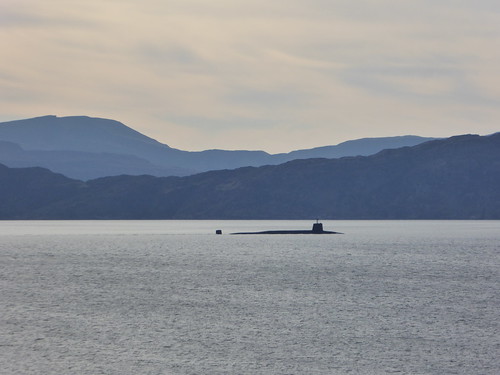Trident missile test fails for second time in a row
Trident #Trident

By Jonathan BealeDefence Correspondent
The HMS Vanguard is one of Britain’s nuclear-powered submarines which can carry the UK’s nuclear weapons
The test firing of a Trident missile from a Royal Navy submarine has failed, for the second time in a row.
The latest test was from HMS Vanguard off the east coast of the US and was witnessed by the defence secretary.
The missile’s booster rockets failed and it landed in the sea close to the launch site, according to the Sun, which first reported the malfunction.
When on patrol the missiles would usually be armed with a nuclear warhead but they are not fitted for test fires.
This is highly embarrassing for both the UK and the US manufacturer of the Trident missile.
British tests of Trident missiles are rare, not least because of the costs. The price tag of each missile is around £17m and the last test was in 2016 when it also ended in failure when the missile veered off course.
Both the Defence Secretary Grant Shapps and the head of the Navy were on board HMS Vanguard, which has just had a more than seven year refit, when it fired the unarmed test missile in January.
A defence source close to the Mr Shapps insisted the Trident “could absolutely fire in a real world situation” if it needed to.
“The issue that occurred during the test was specific to the event and would not have occurred during a live armed fire,” the source said.
A written ministerial statement is expected from Mr Shapps later.
The missile was supposed to have flown several thousand miles before landing harmlessly in the Atlantic between Brazil and West Africa. Instead it dropped into the ocean near to where it was launched.
At the time of the failed 2016 test, the Sunday Times reported that it was launched from HMS Vengeance off the coast of Florida.
The paper said the Trident II D5 missile was intended to be fired 5,600 miles (9,012 km) to a sea target off the west coast of Africa but veered towards the US.
The cause of what went wrong remains top secret, the paper reported, but quoted a senior naval source as saying the missile suffered an in-flight malfunction after launching out of the water.
The Labour Party has called for assurances over the effectiveness of the nuclear deterrent.
Shadow defence secretary John Healey said: “Reports of a Trident test failure are concerning.
“The defence secretary will want to reassure Parliament that this test has no impact on the effectiveness of the UK’s deterrent operations.”
The Campaign for Nuclear Disarmament (CND) described it as an expensive failure following a reported £500m refit.
“We need to stop wasting our money on this,” the group said who campaign to get rid of nuclear weapons in Britain and worldwide.
In a statement the Ministry of Defence admitted an anomaly had occurred in the most recent launch. But it also said that HMS Vanguard and its crew had been “proven fully capable” in their operations and the test had “reaffirmed the effectiveness of the UK’s nuclear deterrent”.
The statement added that Trident was the “most reliable weapons system in the world” having completed more than 190 successful tests.
HMS Vanguard is one of four of the so-called Vanguard nuclear submarines that have been on patrol in 1994, with one of the vessels continually at sea.
The submarines are based at Faslane Royal Navy base on the Firth of Clyde, while the nuclear warheads are stored at the nearby Coulport armaments depot on Loch Long.
The submarines carry US-built Trident 2 D5 nuclear missiles.
The V-class is due to be replaced by the bigger Dreadnought-class submarines in the 2030s.
Between £31bn and £41bn has been put aside for the wider programme of replacing the Vanguard-class submarines, according to the House of Commons Library.